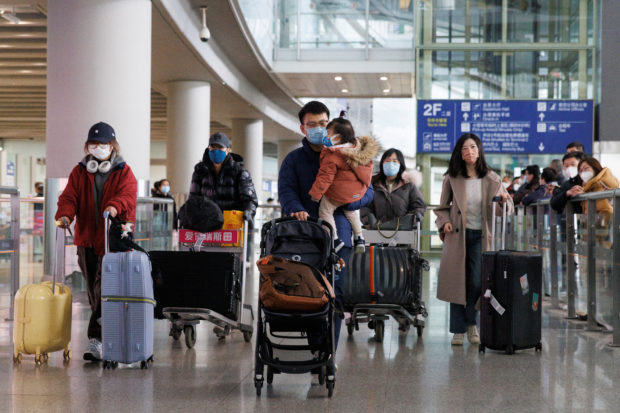
Passengers push their luggage through the international arrivals hall at Beijing Capital International Airport after China lifted the coronavirus disease (COVID-19) quarantine requirement for inbound travellers in Beijing, China January 8, 2023. REUTERS FILE PHOTO
BEIJING — Many parts of China are already past their peak of COVID-19 infections, state media reported on Tuesday, with officials further downplaying the severity of the outbreak despite international concerns about its scale and impact.
A summary by Health Times, a publication managed by People’s Daily, the Communist Party’s official newspaper, said infections have been declining in the capital Beijing and several Chinese provinces. One official was quoted as saying nearly 90 million people had already been infected in Henan province.
The virus has been spreading freely in China since a policy U-turn in early December after protests against a “zero-COVID” regime ruthlessly enforced for three years. China reopened its borders on Sunday, removing the last major restrictions.
The frequent lockdowns, relentless testing and various levels of movement curbs since early 2020 have brought the world’s second-largest economy to one of its slowest growth rates in nearly half a century and caused widespread distress.
With the virus let loose, China has stopped publishing daily infection tallies and has been reporting five or fewer deaths a day since the policy U-turn, figures that have been disputed by the World Health Organisation.
Many Chinese funeral homes and hospitals say they are overwhelmed, and international health experts predict at least 1 million COVID-related deaths in China this year.
On Tuesday, a Health Times compilation of reports from local government officials and health experts across the country, suggested the COVID wave may be past its peak in many regions.
Kan Quan, director of the Office of the Henan Provincial Epidemic Prevention and Control, was cited as saying the infection rate in the central province of nearly 100 million was nearly 90% as of Jan. 6.
The number of patients at clinics in the province reached a peak on Dec. 19, but the number of severe cases was still high, he said, without giving further details.
Yin Yong, acting mayor of Beijing, was cited as saying the capital was also past its peak. Li Pan, deputy director of the Municipal Health Commission in the city of Chongqing said the peak there was reached on Dec. 20.
In the province of Jiangsu, the peak was reached on Dec. 22, while in Zheijiang province “the first wave of infections has passed smoothly,” officials said. Two cities in the southern Guangdong province, China’s manufacturing heartland, reached their peaks before the end of the year.
Separately in the state-run China Daily, a prominent health official said the percentage of severe cases remained unclear.
“It is still too early to conclude the overall percentage of severe and critical COVID patients in China as different types of hospitals report different numbers, Wang Guiqiang, head of Peking University First Hospital’s infectious disease department, was quoted as saying.
Pfizer criticism
China has dismissed criticism over its data as politically-motivated attempts to smear its “success” in handling the pandemic and said any future mutations are likely to be more infectious but cause less severe illness.
Testing requirements introduced by several countries, including the United States, Japan, South Korea, Britain, France and others in response to China’s COVID outbreak, were called out by foreign ministry as “discriminatory.”
Although Beijing also demands negative COVID test results from people landing in China, officials have threatened further retaliation against countries imposing travel curbs that inconvenience the reopening of the $17 trillion economy.
The Chinese embassy in South Korea said on Tuesday it will stop issuing short-term visa for Korean citizens to visit China and that it will adjust the policy subject to Seoul lifting its testing mandate on Chinese visitors.
State media has also taken a swipe at Pfizer Inc over the price for its COVID treatment Paxlovid.
“It is not a secret that U.S. capital forces have already accumulated quite a fortune from the world via selling vaccines and drugs, and the U.S. government has been coordinating all along,” nationalist tabloid Global Times said in an editorial.
Pfizer’s Chief Executive Albert Bourla said on Monday the company was in discussions with Chinese authorities about a price for Paxlovid, but not over licensing a generic version in China.
The abrupt change of course in COVID policies has left China’s health system unprepared, with many hospitals ill-equipped to handle patients in critical conditions and smaller cities scrambling to secure basic anti-fever drug supplies.
Wang Lili, general manager at a factory making medical products for hospitals in Beijing’s CR Double Crane Industrial Park, told Reuters that intravenous drips were their most in-demand product.
The company has since Jan. 5 done away with weekends to meet demand.
“We are running 24/7,” Wang said.
RELATED STORIES